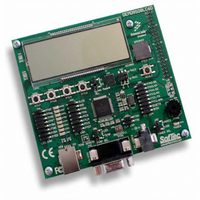DEMO9S08LC60 Freescale Semiconductor, DEMO9S08LC60 Datasheet - Page 291

DEMO9S08LC60
Manufacturer Part Number
DEMO9S08LC60
Description
BOARD DEMO FOR 9S08LC60
Manufacturer
Freescale Semiconductor
Type
MCUr
Datasheets
1.DEMO9S08LC60.pdf
(360 pages)
2.DEMO9S08LC60.pdf
(32 pages)
3.DEMO9S08LC60.pdf
(2 pages)
Specifications of DEMO9S08LC60
Contents
Evaluation Board
Processor To Be Evaluated
MC9S08LC60
Interface Type
RS-232, USB
Silicon Manufacturer
Freescale
Core Architecture
HCS08
Core Sub-architecture
HCS08
Silicon Core Number
MC9S08
Silicon Family Name
S08LC
Rohs Compliant
Yes
For Use With/related Products
MC9S08LC60
Lead Free Status / RoHS Status
Lead free / RoHS Compliant
- Current page: 291 of 360
- Download datasheet (4Mb)
15.6.2.4
The ADC quantizes the ideal straight-line transfer function into 4096 steps (in 12-bit mode). Each step
ideally has the same height (1 code) and width. The width is defined as the delta between the transition
points to one code and the next. The ideal code width for an N bit converter (in this case N can be 8, 10 or
12), defined as 1
There is an inherent quantization error due to the digitization of the result. For 8-bit or 10-bit conversions
the code will transition when the voltage is at the midpoint between the points where the straight line
transfer function is exactly represented by the actual transfer function. Therefore, the quantization error
will be ± 1/2
conversion is only 1/2
For 12-bit conversions the code transitions only after the full code width is present, so the quantization
error is -1
15.6.2.5
The ADC may also exhibit non-linearity of several forms. Every effort has been made to reduce these
errors but the system should be aware of them because they affect overall accuracy. These errors are:
Freescale Semiconductor
•
•
•
•
•
•
•
Average the result by converting the analog input many times in succession and dividing the sum
of the results. Four samples are required to eliminate the effect of a 1
Reduce the effect of synchronous noise by operating off the asynchronous clock (ADACK) and
averaging. Noise that is synchronous to ADCK cannot be averaged out.
Zero-scale error (E
the actual code width of the first conversion and the ideal code width (1/2
modes and 1
the actual $001 code width and its ideal (1
Full-scale error (E
the last conversion and the ideal code width (1.5
mode). Note, if the last conversion is $3FE, then the difference between the actual $3FE code width
and its ideal (1
Differential non-linearity (DNL) — This error is defined as the worst-case difference between the
actual code width and the ideal code width for all conversions.
Integral non-linearity (INL) — This error is defined as the highest-value the (absolute value of the)
running sum of DNL achieves. More simply, this is the worst-case difference of the actual
transition voltage to a given code and its corresponding ideal transition voltage, for all codes.
Total unadjusted error (TUE) — This error is defined as the difference between the actual transfer
function and the ideal straight-line transfer function, and therefore includes all forms of error.
LSB
LSB
Code Width and Quantization Error
Linearity Errors
to 0
LSB
in 8- or 10-bit mode. As a consequence, however, the code width of the first ($000)
LSB
LSB
, is:
LSB
and the code width of each step is 1
LSB
in 12-bit mode). Note, if the first conversion is $001, then the difference between
FS
) is used.
and the code width of the last ($FF or $3FF) is 1.5
ZS
) — This error is defined as the difference between the actual code width of
MC9S08LC60 Series Data Sheet: Technical Data, Rev. 4
) (sometimes called offset) — This error is defined as the difference between
1
LSB
= (V
REFH
- V
LSB
REFL
) is used.
LSB
) / 2
LSB
N
in 8-bit or 10-bit modes and 1
.
Chapter 15 Analog-to-Digital Converter (S08ADC12V1)
LSB
LSB
, one-time error.
.
LSB
in 8-bit or 10-bit
LSB
in 12-bit
Eqn. 15-2
291
Related parts for DEMO9S08LC60
Image
Part Number
Description
Manufacturer
Datasheet
Request
R
Part Number:
Description:
Manufacturer:
Freescale Semiconductor, Inc
Datasheet:
Part Number:
Description:
Manufacturer:
Freescale Semiconductor, Inc
Datasheet:
Part Number:
Description:
Manufacturer:
Freescale Semiconductor, Inc
Datasheet:
Part Number:
Description:
Manufacturer:
Freescale Semiconductor, Inc
Datasheet:
Part Number:
Description:
Manufacturer:
Freescale Semiconductor, Inc
Datasheet:
Part Number:
Description:
Manufacturer:
Freescale Semiconductor, Inc
Datasheet:
Part Number:
Description:
Manufacturer:
Freescale Semiconductor, Inc
Datasheet:
Part Number:
Description:
Manufacturer:
Freescale Semiconductor, Inc
Datasheet:
Part Number:
Description:
Manufacturer:
Freescale Semiconductor, Inc
Datasheet:
Part Number:
Description:
Manufacturer:
Freescale Semiconductor, Inc
Datasheet:
Part Number:
Description:
Manufacturer:
Freescale Semiconductor, Inc
Datasheet:
Part Number:
Description:
Manufacturer:
Freescale Semiconductor, Inc
Datasheet:
Part Number:
Description:
Manufacturer:
Freescale Semiconductor, Inc
Datasheet:
Part Number:
Description:
Manufacturer:
Freescale Semiconductor, Inc
Datasheet:
Part Number:
Description:
Manufacturer:
Freescale Semiconductor, Inc
Datasheet:










